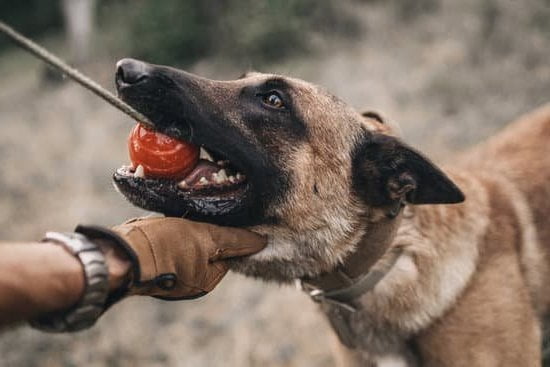Are you tired of constantly having to get up from the couch to retrieve the remote? What if there was a way to train your furry friend to do it for you? In this article, we will explore the process of training your dog to get the remote, an everyday task that can showcase your dog’s natural abilities and intelligence.
Teaching your dog new tricks not only provides mental stimulation but also strengthens the bond between you and your pet. By involving them in everyday tasks like fetching the remote, you are giving them a sense of purpose and responsibility. This type of training can also be beneficial for dogs with high energy levels or those who may struggle with behavioral issues.
Understanding your dog’s natural abilities and instincts is crucial in successfully teaching them to get the remote. Whether it’s their innate desire to chase after objects or their strong sense of smell, tapping into these instincts can make the training process more effective and enjoyable for both you and your dog.
In the following sections, we’ll explore how basic obedience training, positive reinforcement, and patience can play a key role in this training process. So let’s dive into understanding how to train your dog to get the remote.
Understanding Your Dog
Exploring your dog’s natural abilities and instincts is key to understanding how they can be trained to get the remote. Dogs have an incredible sense of smell, sight, and hearing, which can be utilized when teaching them this task. Their natural instinct to fetch and retrieve items can also be harnessed for this purpose. Understanding these traits in your dog will allow you to tailor your training approach to their specific strengths.
To begin exploring your dog’s abilities, consider their breed and individual characteristics. Some breeds are naturally better at tasks involving fetching and retrieving, while others may excel in using their sense of smell to locate objects. Additionally, take note of your dog’s behavior during playtime or when they’re engaged in other activities. Are they particularly good at finding hidden toys? Do they enjoy carrying items in their mouth?
Once you have a good understanding of your dog’s natural abilities and instincts, you can start to think about how these traits can be used to train them to get the remote. For example, if your dog has a strong sense of smell, you may use scent-based training methods to help them locate the remote.
If they enjoy carrying objects around, you can work on teaching them how to pick up and bring the remote to you upon command.
By understanding your dog’s innate abilities and instincts, you can tailor your training approach to suit their strengths, making it more effective and enjoyable for both you and your furry companion.
Basic Obedience Training
Setting a Strong Foundation
Before moving on to more complex tasks like retrieving the remote, it’s crucial to ensure that your dog has mastered basic obedience commands. These commands not only form the groundwork for future training but also establish your role as the leader in your relationship with your dog. Training your dog to respond reliably to these commands sets the stage for successful learning and builds trust between you and your pet.
Developing Communication
Teaching commands such as sit, stay, and fetch strengthens communication between you and your dog. This communication is vital when learning new skills or addressing behavior issues. Basic obedience training allows you to establish clear cues that guide your dog’s actions, creating a foundation for more complex tasks like fetching the remote.
By focusing on basic obedience training first, you can lay a solid groundwork that will make it easier for your dog to learn new skills in the future. Patience and consistency are key during this foundational training phase, setting the stage for successful integration of more advanced behaviors such as retrieving the remote.
Getting Started
Before you begin training your dog to get the remote, it’s important to establish a positive and conducive training environment. Choose a quiet, distraction-free area where you can focus on the training sessions without too much interference. Keep in mind that consistency is key, so try to schedule regular training sessions at the same time each day to help your dog get used to the routine.
When setting up the initial training sessions, make sure to have all the necessary tools on hand. This includes the remote control, treats or rewards for positive reinforcement, and a clicker if you choose to use one. Having everything prepared ahead of time will help streamline the training process and prevent any unnecessary delays.
It’s also essential to approach each training session with a calm and patient demeanor. Dogs are very intuitive animals and can pick up on their owner’s emotions, so maintaining a positive attitude throughout the training process is crucial. Remember that learning a new trick takes time and persistence, so be patient with your furry friend as they navigate through the learning process.
| Training Environment | Initial Sessions |
|---|---|
| Quiet, distraction-free area | Have all necessary tools ready (remote control, treats) |
| Schedule regular sessions | Approach with patience and positivity |
Step-by-Step Training Process
When teaching your dog to get the remote, it’s important to break down the training process into manageable steps. This helps your dog understand what is expected of them and allows for gradual progress as they learn this new trick.
The first step is to introduce the remote in a way that makes it a positive and familiar object for your dog. Start by placing the remote on the floor or a low surface and allow your dog to approach and investigate it on their own terms.
Once your dog is comfortable with the presence of the remote, you can begin associating it with a specific command, such as “get the remote” or “bring it here.” Use this command consistently while introducing the remote, so that your dog starts to make an association between the command and the action of retrieving the remote. Be patient during this process, as it may take some time for your dog to fully understand what is being asked of them.
As your dog becomes familiar with the command and understands that it means they should get the remote, you can begin working on having them pick it up and bring it to you. Start by rewarding small steps of progress, such as touching the remote with their nose or picking it up briefly. Gradually increase your expectations until your dog is confidently bringing you the remote when given the command.
While training in this step-by-step process, it’s important to use positive reinforcement consistently. This can include verbal praise, treats, or toys as rewards for following through with each step of retrieving the remote. By maintaining patience and consistency in this training process, you can effectively teach your dog how to get the remote and make it an enjoyable experience for both of you.
| Training Step | Description |
|---|---|
| Introducing Remote | Allowing dog to explore and investigate remote in a controlled setting. |
| Associating Command | Consistently using a command like “get the remote” while introducing and interacting with the object. |
| Retrieving Remote | Gradually increasing expectations until dog confidently brings you the remote upon command. |
Positive Reinforcement
Choosing the Right Rewards
When it comes to positive reinforcement, selecting the right rewards for your dog is important. These rewards can include treats, praise, toys, or any other items that your dog finds motivating. It’s essential to understand what truly motivates your dog and use those rewards consistently during training sessions.
Timing and Consistency
Another key aspect of using positive reinforcement is timing. It’s important to deliver the reward immediately after your dog successfully performs the desired behavior. This will help them understand which actions lead to rewards, making them more likely to repeat those behaviors in the future. Consistency is also vital – make sure to reward your dog every time they successfully retrieve the remote during training.
Avoiding Negative Reinforcement
While using positive reinforcement, it’s equally important to avoid negative reinforcement. Punishing your dog for not getting it right can lead to confusion and stress, ultimately hindering their progress. Instead of focusing on what they did wrong, concentrate on rewarding their successes and patiently guiding them through any challenges they encounter.
By utilizing positive reinforcement effectively, you can create a rewarding and enjoyable training experience for both you and your dog as you work together towards teaching them how to get the remote safely and consistently.
Troubleshooting
When training your dog to get the remote, there are common challenges and mistakes that owners may encounter. It’s important to be aware of these potential issues and have a plan for overcoming them in order to make the training process successful. Here are some common challenges and mistakes to avoid when teaching your dog to get the remote, along with solutions for overcoming them:
1. Lack of motivation: Some dogs may lack the motivation to retrieve the remote, especially if they don’t find it inherently rewarding. To overcome this challenge, you can use high-value treats or toys as rewards for successfully fetching the remote. Additionally, incorporating playtime and praise into the training sessions can help increase your dog’s motivation.
2. Distractions: Dogs can easily get distracted, especially when learning a new task. It’s important to start training in a quiet and familiar environment before gradually introducing distractions. Avoid noisy or crowded areas during initial training sessions, and gradually increase the level of distractions as your dog becomes more proficient at retrieving the remote.
3. Inconsistency in commands: Using inconsistent or unclear commands can confuse your dog and make it difficult for them to understand what is expected of them. Make sure to use clear and consistent commands such as “get the remote” or “bring it here” during training sessions so that your dog understands what they are supposed to do.
By being aware of these common challenges and mistakes, you can better prepare for them during the training process. With patience, consistency, and positive reinforcement, you can successfully teach your dog to retrieve the remote and enjoy the benefits of their newfound skill in daily life.
Consistency and Patience
Training your dog to get the remote or perform any other specific task requires a great deal of consistency and patience. It’s important to remember that every dog learns at their own pace, and it may take time for them to grasp the concept of retrieving the remote. Consistency in your training methods and expectations will be key to helping your dog succeed in this endeavor.
One way to maintain consistency during training is to establish a regular schedule for training sessions. Carve out dedicated time each day to work with your dog on retrieving the remote, ensuring that they have the opportunity to practice and reinforce their learning. Consistency in timing, location, and duration of training sessions can help your dog understand what is expected of them and when they need to perform.
In addition to consistency, patience is equally crucial when teaching your dog new tasks. Understand that there may be setbacks and challenges along the way, but patience will be essential in overcoming these obstacles.
Keeping a calm and positive attitude during training sessions will help your dog feel more at ease and motivated to continue learning. Remember that each small success should be celebrated as progress towards the ultimate goal of having a helpful companion who can assist with everyday tasks like getting the remote.
Real-Life Applications
In conclusion, training your dog to get the remote is not only a fun and impressive trick, but it also has practical applications in daily life. By understanding your dog’s natural abilities and instincts, you can effectively train them to assist with everyday tasks. Not only will this create a stronger bond between you and your pet, but it can also make your life easier.
It’s important to remember that the key to successfully teaching your dog to get the remote or any other task is consistency and patience. Consistent training sessions and positive reinforcement are essential for helping your dog understand what is expected of them. Additionally, patience is crucial as every dog learns at their own pace, and it may take time for them to fully grasp the concept.
In addition to retrieving the remote, there are numerous other fun tasks that you can teach your dog to assist with. From fetching items like slippers or the newspaper to turning lights on and off, the possibilities are endless.
Training your dog not only provides mental stimulation for them but also strengthens the bond between you and provides a sense of fulfillment for both you and your furry companion. So, whether it’s getting the remote or learning new tricks, training your dog can be a rewarding experience for both of you.
Frequently Asked Questions
How Do I Teach My Dog to Find the Remote?
Teaching your dog to find the remote involves using positive reinforcement and scent training. Start by introducing the remote as a toy and rewarding your dog when they show interest in it.
Gradually incorporate the remote’s scent into a game of hide and seek, rewarding them when they successfully locate it. With consistent practice and patience, your dog can learn to associate finding the remote with positive reinforcement.
What Is Remote Dog Training?
Remote dog training is a method of teaching your dog commands or behaviors using a remote-controlled device, such as a vibrating collar or shock collar. This type of training allows you to give your dog immediate feedback from a distance, helping them understand what is expected of them even when you are not physically present.
It’s important to use remote training devices responsibly and always prioritize positive reinforcement techniques in conjunction with this method.
How Do You Teach a Dog to Retrieve Objects?
Teaching a dog to retrieve objects involves breaking down the behavior into smaller steps and using positive reinforcement. Start by getting your dog interested in the object, then encouraging them to pick it up.
Gradually increase the distance they need to retrieve the object, rewarding each successful attempt. With consistent practice and patience, most dogs can learn to retrieve objects on command through this methodical approach.

Welcome to the blog! I am a professional dog trainer and have been working with dogs for many years. In this blog, I will be discussing various topics related to dog training, including tips, tricks, and advice. I hope you find this information helpful and informative. Thanks for reading!





